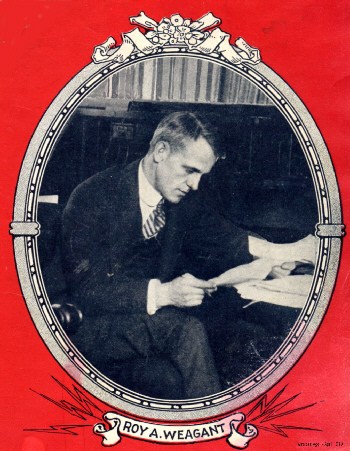The History of InfoAge Science & History Museums
Static Elimination Disclosure – November 18, 1918Static Elimination Disclosure – November 18, 1918

Photo of Roy Weagant published in Wireless Age 1919
A secret invention perfected in Wall was unveiled to the world 100 years ago this week.
It was July 4th, 1917 in Wall when Guglielmo Marconi was shown the breakthrough invention at his giant wireless station, known today as Camp Evans. His face lit up with a smile, he said “Most extraordinary, I have never seen anything to compare with it”. Many had tried to accomplish this and had failed. Marconi also said, “It is worth millions”. The invention was kept secret by the U.S. Navy from then on. With the Great War ending on November 11th, 1918 this key invention was unveiled to the world. It would enable the radio to be born.
Hundreds of newspapers across the nation would report the advance. The inventor was hailed as a genius by great scientists, including Thomas Edison. “Marconi invented the wireless and Mr. Weagant has perfected it” Edward Nally, the president of Marconi Wireless, told the press. Headlines reported that “A new era in world communications” was ahead. Even the Wall Street Journal speculated on the future stock value of wireless and supporting industries.
The radio quality we enjoy today is a miracle compared to the original wireless. The problem was static. It was so bad that wireless stations could only hear messages six to seven hours a day. There was so much static that the wireless operators gave the static names such as “buzzes”, “bangs”, “hisses” “clicks” and “crashes”. With the invention, messages could be heard twenty-four hours a day. The static distorted most attempts at voice transmission. So wireless could only send Morse code, no voice.
The inventor was Roy Weagant. His invention was called ‘static elimination’. Much of the work was done in Wall. Some were done in Lakewood, NJ, Miami, Fl. and Roselle Park, NJ.
During the Great War, static elimination gave the Allies a strategic advantage over the Germans. It allowed the Allies to send more messages, further and faster. Allied wireless operators could listen in to distant German communications and the Germans had no clue. With clear communications 200 words, a minute could be transmitted in code. That is about one kilobyte. Could you live with a one-kilobyte cell phone service? Weagant’s static elimination and Ernst Alexanderson’s fantastic alternator would enable President Wilson to stay in communication with the White House as he traveled on the U.S.S. Washington to the Paris peace conference. Wireless was so important that historians of technology call the Great War the ‘wireless war’. Camp Evans was in the center of it.
Within a year of the Armistice, a former Marconi Company manager named David Sarnoff would propose the ‘Radio Music Box’. By 1925 there were hundreds of thousands of radios in homes. With new technologies stations could transmit music and voice without static drowning the transmission. The press prediction of a new era in communications came true. The radio star was born. So were commercials.
The November 1918 papers also predicted that it was the ‘end of giant wireless towers’. The six-four hundred-foot towers in Wall became obsolete. Sometime in 1925, Camp Evans went radio silent. It appeared Camp Evans radio days were gone forever. But, a new radio invention made a few miles north at Fort Monmouth called radar would bring innovation back to Wall in 1940.
The old Marconi Station that played a key role in the ‘Wireless War’ would play a major role in the ‘Radar War’ known as WWII. America is a country built on innovation. Camp Evans holds such a special place in communications history. Much credit is due to Wall and the volunteers of InfoAge for saving this amazing site for future generations. Your support of their efforts makes Wall a better place.
There are no upcoming events at this time
We Need Your Help! Volunteer with Us.
Join our mission to preserve historic Camp Evans and teach the public about science and history.
Sign up to join our team of volunteers and start on your own mission today.
InfoAge Science & History Museums
2201 Marconi Road
Wall, NJ 07719
Tel: 732-280-3000
info@infoage.org
webmaster@infoage.org